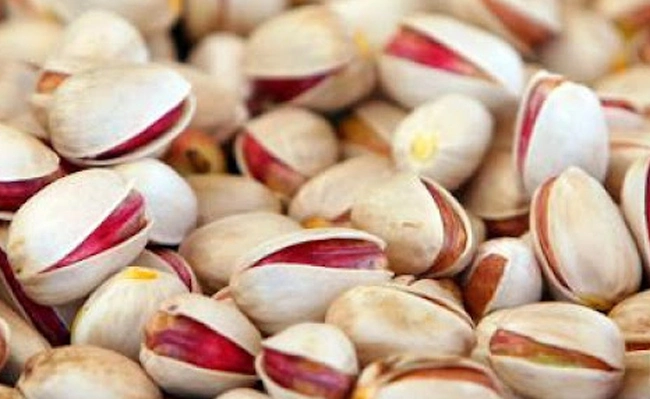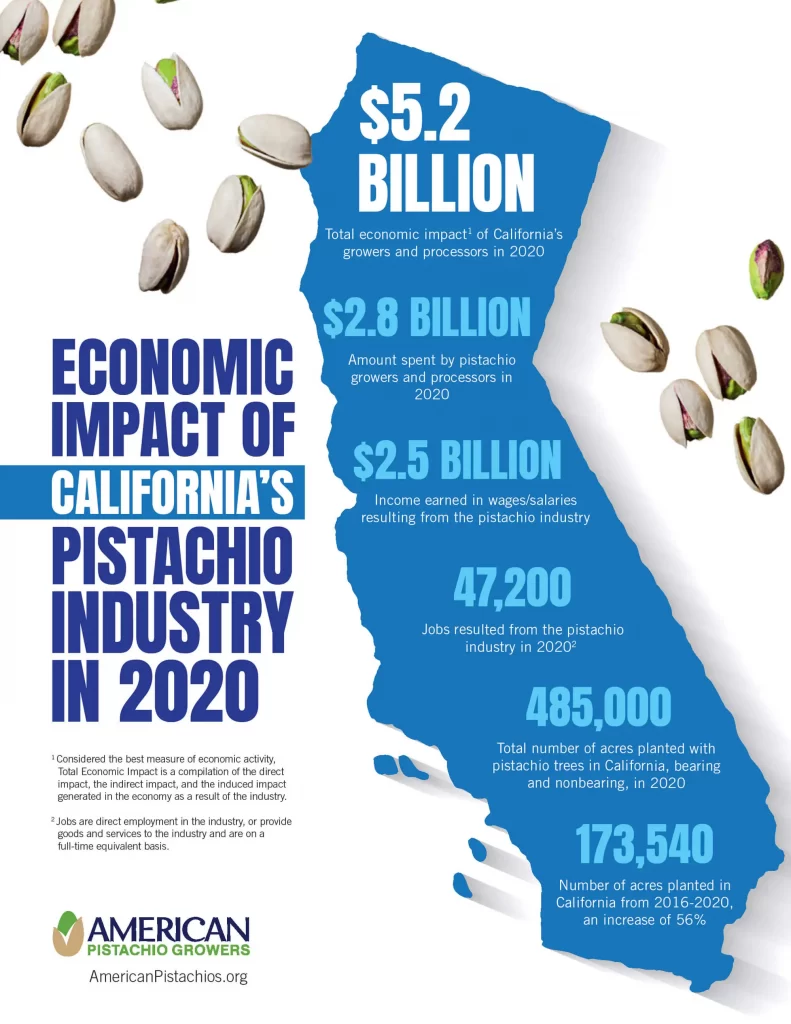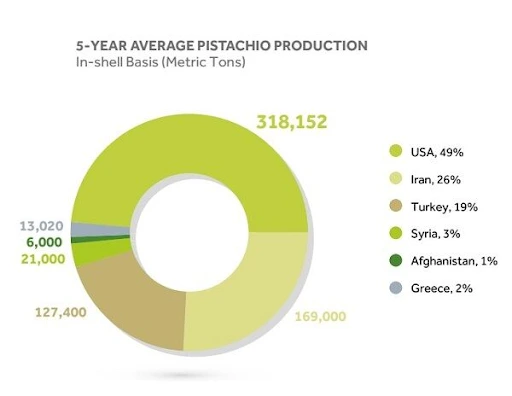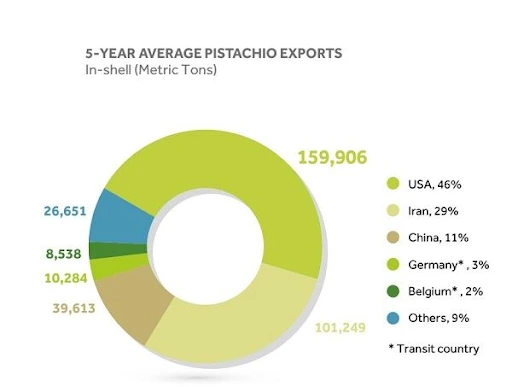Pistachio consumption has increased in the last few years. This has created intense competition over pistachio production and marketing. The leading pistachio producing countries in the world are the USA, Iran, and Turkey, with 90% of the global share. Syria, Afghanistan, Spain, and a few other countries make up the remaining 10%.
The US is the largest producer and exporter of in-shell pistachios in the world. Iran is the second-largest producer of in-shell pistachios and the leading exporter of pistachio kernels (pistachio products). Turkey is emerging as the new supplier of pistachio nuts.
The leading pistachio producing countries have been boasting their past and present success. In this article, we will see who gets the cake and why. We also take a closer look at the US’s pistachio war with Iran, saving the Turkish pistachio industry discussion for another post.
- Iran is Moving away from Traditional Practices
- The U.S. Has A Billion Dollar Pistachio Industry
- Pistachio Production Outlook (2022)
- Pistachio Producing Benchmark: Who Gets the Cake
- Global Market Share: US vs Iran Vs Turkey vs Syria
- Competition over the European Market
- The US Pistachio War with Iran Killing California for a Snack Food!
Iran is Moving away from Traditional Practices
As the pistachio’s origin country, Iran was the largest pistachio producing nation for thousands of years. Though lost the race to the US under heavy economic sanctions, it still bIran is the pistachio’s origin country. It was the largest pistachio producing nation for hundreds of years. The country lost the race to the US under heavy economic sanctions, but it still produces the best pistachios in the world.
Pistachio production in Iran can be discussed at several levels.
At the variety improvement level
New cultivars with desirable features have been developed and distributed among farmers. For example, new cultivars (Ahmad Aghaei and Akbari) have a larger production efficiency than older ones. They also have a higher oil content. Rich oil content allows for roasting at higher temperatures which brings out the unique flavor of nuts.
At the pistachio production level
- New pistachio trees have been planted with cultivars. The horticulture practices (e.g., making better use of water) in current orchards have been improved. Newly matured orchards in water-abundant areas have stabilized the production of Iranian pistachios.
Currently, Iran’s annual production of pistachio is 135,000 metric tons. It is predicted that production will remain at that level for years to come. The record pistachio production was 267,000 tons in 2007.
At the grower level
A combination of factors has contributed to the growth in pistachio production capacity in Iran. These factors include adopting new irrigation methods (such as the substitution of flood irrigation with drip irrigation), applying more residue-free pesticides, and timely and speedy harvest, reducing the time lapse between harvesting and processing. Also, farmers have learned how to reduce aflatoxin and crop loss.

At the processing and supplying level
Iranian farmers, manufacturers, and suppliers have learned to cooperate together. They now use the most advanced knowledge for processing, packaging, and preventing aflatoxin after production. This has resulted in better quality control and more international customer satisfaction.
At the pistachio processing level
Iran is moving from traditional low-capacity pistachio processing factories toward industrial high-capacity units. There weren’t enough processing factories in the country in the past. So it mostly exported naturally open in-shell pistachios. The number of mechanized processing units is growing every year. And the country has added new products to its portfolio. These include closed shells (11%) natural kernels (9%), Green peeled Pistachio Kernel (GPPK, 2%) and other forms (3%). Now the country has the capacity to process 400 MT of fresh pistachios per day. This is equal to 130 MT of dried in-shell nuts per day.
At the commercial level
Many growers, manufacturers, producers, exporters, and domestic and overseas suppliers of Iranian pistachios have created a competitive market.
The U.S. Has A Billion Dollar Pistachio Industry
The pistachio producing industry in the US has grown from a single seed in the 1930s to a world-class industry in 2021. The industry is now worth billions. The country has fertile soil, a hot, dry climate, and moderately cold winters in the pistachio growing areas. It uses cutting-edge technology and horticulture advancements for pistachio production.
Today, California is the top pistachio producing state in the U.S with 99 percent of the production share. There are more than 950 pistachio producers in the U.S. They leave a $5.2 billion worth impact on California’s economy and the remaining states (Figure 2).

The first introduction of pistachio nuts to America goes back to the 1880s. During that time pistachios became popular in the USA by Middle Eastern immigrants. Pistachios were sold by vending machines in subway stations, bars, and restaurants. A dozen of pistachios were sold for a nickel.
Cultivation of pistachio in the U.S. started in the 1930s. American botanist William E. Whitehouse brought back around 10 kilograms of pistachio nuts from Persia. Only one pistachio sample could show promise. He named the cultivar “Kerman”, after the city near where he found the seeds. Until the 1980s, scientists and botanists conducted many experiments on the Kerman cultivar to make it stronger. The concept of the American pistachio industry became a reality.
Other popular pistachio cultivars in the U.S. include Platinum, Pioneer Gold, Joley, and Red Aleppo, to name a few.
For the first time, the U.S. produced only 680 tons of pistachios in 1976. This was not enough to support the domestic market. The pistachio production increased slowly over the next 40 years. More new pistachio orchards were established over the years. The yield per acre went from 665 kilograms per acre, in 1982, to over 1,726 kilograms per acre in 2010. In 202, the country produced 477,000 metric tons of pistachio.
Fresh pistachios make the tree-to-silo trip in less than 24 hours. They never touch the ground once they’re shaken from the trees. Instead, they are collected in catch frames and large bins and sent immediately by truck to the pistachio processing facility. There they are cleaned and hulled.
Many pistachio groves in the US are owned by famous companies such as Wonderful or Paramount. These companies approach processing with speed and accuracy in mind. For example, Paramount Farms’ processing facilities are located close to the fields. They use the most advanced processing technology.
Pistachio Production Outlook (2022)
In recent years, the US, Iran, and Turkey have faced adverse climate conditions such as heat and water shortages and frost. This year’s harvest is slightly different as Iran expects a good crop, and the US new plantings will bear. The story is a bit different for Turkey.
The U.S.
The season 2021/22 is a good “off-year” in California. The weather condition has been especially favorable to pistachio production. There were enough chill hours from November to February. So it is expected that American Pistachio Growers will harvest a large crop (477,000 MT) this season. Along with the large carry-over (65,000 MT) from 2020/2021, this year’s crop is going to help to stabilize the supply.
The domestic demand for pistachio as a healthy snack rose by 10% during the Pandemic. Some of the pandemic-related habits will be carried forward into the future. So it seems that the demand will remain high and the industry will continue to grow for years to come. Also, the US pistachio market will experience a remarkable demand for pistachio kernels.
Despite ongoing water issues in California, the available water is expected to be sufficient for this season. More and more growers are adapting sustainable farming to improve water penetration. For example, more farmers are using cover crops and compost to reduce water needs. Also, more pistachio farmers use agronomic practices that can improve the quality of pistachio nuts.
These practices include harvesting early and shaking twice, applying winter sanitation, and utilizing mating disruption pest control.
Pistachio acreage increases at a rate of 5-7 % with new plantings coming in every year. Some of these new plantings are going to enter production this year and their crop will reflect in the 2022 harvest.
The new tariffs on the Chinese market are the biggest challenges facing American Pistachio Growers.
Iran
The future looks bright for Iranian pistachios despite stumbling blocks. It seems that Iranian pistachio growers have finally learned their lessons.
The Iranian Pistachio Association (IPA) has estimated the new crop to be around 150,000 MT. This is 40% down from the average (200,000) due to frost and heat damage. It predicts that the Iranian crop will reach and remain at 200,000 MT on average in the next 4-5 years.
The new crop will be composed of Ahmad Aghaei (36% ), Fandoghi (32% ), 17% Jumbo (17% ) and Akbari (15%). Akbari pistachio will be yielding a small crop due to the frost damage. This particular pistachio cultivar is more sensitive than the others.
The 27 states in Iran represent 340,000 hectares of bearing pistachio orchards and there will be new plantings coming in each year. There are over 400,000 hectares planted with pistachios (bearing and non-bearing). Most of these are small-scale units owned by individuals rather than businesses.
Productivity varies between 100 to 4,000 kg/ha due to inefficient irrigation systems, low water utility efficiency, strong winds, frost, and drought damage.
Pistachio cultivation in several geographical areas will help stabilize production in the future. The future production will consist mostly of Akbari (long pistachios) as the new plantings are mostly of this cultivar.
Turkey
A very strong off-year is awaiting Turkish pistachios. The weather conditions have been unfavorable this year. So the production volume is expected to fall by 70% to around 89,000 MT in-shell. The productivity (yield per acre) is forecasted to be around 560 kg/ha.
The country has 218,000 hectares of pistachio groves, but new plantings are underway. Growing regions are expanding, especially in the South East of the country. It is hoped that modern irrigation programs and agronomical practices will improve pistachio yield per unit of land area.
Pistachio Producing Benchmark: Who Gets the Cake
The US, Iran, and Turkey have cultivated new plantings. They have also found ways to mitigate climate influence on pistachio production. But, winning the pistachio competition depends more on the pistachio’s quality than quantity. After all, pistachios are what consumers take home. This section discusses the winning odds for the three countries from a consumer point of view.
Production Yield
Iran produces around 172,000 tons of in-shell pistachios from 340,000 hectares of bearing pistachio orchards. The country has a total of 400,000 hectares of bearing and non-bearing plantings. But, the productivity is very low. It ranges from 100 kg/ha to 4,000 kg/ha.
There are 130,000 hectares of bearing pistachio groves in the US. The number increases by a rate of 5.7 percent each year. The productivity ranges from 2400 to 4000 kg/ha, depending on whether it is an off-year or on year. Experts predict that pistachio production in California will reach 660,000 kg/ha by 2026. However, unusual weather conditions like drought or insufficient chilling hours make the prediction uncertain.
Production Variability
Climate conditions may cause fluctuations in pistachio production. These include drought, unusual summer heat, spring frosts, hail storms, poor water management, and after-harvest waste.
Another cause of production variability has biological reasons. Pistachio is an alternate bearing plant. It yields a larger crop in one year (on year) and a smaller crop the following year (off-year). Production tends to reduce by nearly 50% in the off years. Alternate bearing is not related to adverse climatic conditions or mismanagement practices. Almost all pistachio nut trees show alternate bearing habits. Iranian pistachios and American pistachios show alternate bearing patterns. But it is less severe than we see in Turkish cultivars. Iranian pistachios and Turkish Siirt cultivar show “relative” alternate bearing habits. American “Kerman,” shows typical alternate-bearing patterns.
Pistachio Split Rate
If purchasing in bulk, you should look for pistachios whose shells are split or partly split open. This shows ripeness. Closed-mouth pistachios may hold an immature nut. And sometimes they should be avoided.
Iranian pistachios have a higher rate of natural splitting. For this reason, they are known as “smiling nuts” or “happy nuts.” There is a big demand for Iranian-origin pistachios because they are large and have a high splitting rate (around 95% to 96%). Information on the internet regarding the splitting rate in American and Turkish pistachios is scarce.
Pistachio Shell-hinge Strength
Shelling-hinge strength refers to the tendency of the pistachio nut to split easily. But it has sufficient strength to prevent it from falling apart in hulling or later in storage or transportation.
Greater shell-hinge strength in Iranian pistachios means they have less shelling stock in the package. Shelling stocks are loose shells that must be removed or kernels that have separated from their shells.
There should be no more than 5% loose shells in the package. Splitting should also be more than 95%.
Pistachio Appearance
As shown in figure 2, American pistachios are larger and plumper than their Iranian or Turkish counterparts. But, American pistachios contain more blanks (because of severe summer heat). They are more likely to produce shell stock or peel off, with broken shells or skin pieces in the packet. They also look paler than Iranian or Turkish pistachios.
Iranian pistachios have a yellowish shell. Turkish pistachios have the darkest shell color because they process them when pistachios still have their hulls on.
Kernel-to-in-shell Ratio
Across all top Pistachio producing countries, Iranian pistachios have the highest kernel-to-in-shell ratio. You get a higher quantity of edible meat per ounce or kilogram by buying Iranian pistachios. The reason is that Iran’s weather is more suitable for growing pistachios, and pistachios have enough time to fill the Kernel.
Pistachio Roastability
Roasting means cooking over direct heat. Excellent roasting at a higher temperature brings out the unique flavor of Pistachio. It also removes any live bacteria from the roasted nut.



Pistachio Taste and Flavor
People worldwide have always preferred the flavor and taste of Iranian pistachios. Iranian pistachios have a rich and distinctive flavor. Turkish pistachios are also tasty for the same reasons. American pistachios are less tasty than Iranian or Turkish pistachios.
Tradability
Nowadays, pistachio-producing suppliers can trade pistachios in locations far from their production sites.
Tradability varies among pistachio types. Generally, the tradability of Iranian and Turkish pistachios surpasses that of American Pistachios. But, American pistachios stand a better chance in populated markets.
Research shows that suppliers who import Iranian or Turkish pistachios have a higher income. But, the result was the opposite for American pistachios. The taste and use of American pistachios are different.
The distance between suppliers and consumers does not affect the trade of Iranian pistachios due to product quality. Also, the transportation costs do not affect the trade of Iranian pistachios. Consumers are more willing to buy Iranian pistachios without considering their costs. (Source Int J Agric For Life Sci (2020) 4(2): 255-262)
Turkish and Iranian pistachios are more suitable for direct consumption. American pistachios (non-split or badly stained) are mainly used as ingredients.
Global Market Share: US vs Iran Vs Turkey vs Syria
The USA (477,000 MT), Iran (190,000 MT), and Turkey (127,000 MT) account for 49%, 26%, and 19% of the world’s production share, according to a 5-year production average report by INC issue 2020/2021 (Figure 4). The same report for the global pistachio in-shell export shows that the U.S. leads the world with 219,155 metric tons, accounting for 46% of the total share.
The same report for the global pistachio in-shell export shows that the U.S. leads the world with 219,155 metric tons, accounting for 46% of the total share.


Highlights
- The US is the largest consumer of pistachios in the world. After the United States, Turkey is the second-largest global consumer of pistachios.
- American Pistachio export faces intense competition from Iran due to its decent crop in 2021.
- Turkey is a rising supplier of pistachio, especially to the European (Italy and Germany) and Chinese markets. Export from Turkey increased from 820 tons in 2014 to 30,000 tons in 2020.
- The top destinations for American pistachios are China (44% of the country share), the European Union, and the United Kingdom (34%).
- Iran is the world’s largest exporter of pistachio kernels (pistachio products) in the world. It supplies up to 70% of the world’s total Kernel exports. The United States follows with 20% on average.
- The main destinations of Iran’s pistachio exports, in order of export volume, are China (63%), European countries (16%), the Middle East (12%), and India (11%).
- Germany accounts for 50% of the export share going to the European Union. Spain is the fastest-growing market for Iranian pistachios in Europe. Exports to Spain have doubled from 600 tons in 2014 to 1300 tons in recent years.
- The market trend for Iranian pistachios is changing from wealthy countries to developing countries. Pistachios are exported according to the buyers’ obligations and standards. These standards should match the minimum Iranian national criteria.
Competition over the European Market
The European market for pistachios is very concentrated and dominated by the two largest suppliers (the United States and Iran). The two countries supply 99% of the total market, with the United States almost 77% and Iran 22% share.
Turkey, Syria, and Greece continue to challenge the U.S. and Iran over the European market. The pistachio export from Turkey to Germany (the leading importer of pistachios across Europe) has increased in recent years, reaching up to 2,064 tons.
Syria has shown steady growth in pistachio production in past years. The country’s export to the European Union increased from 37 tons in 2014 to 127 tons in 2018.
The US Pistachio War with Iran
Killing California for a Snack Food!
(A Documentary Film)
The “pistachio war” is a term used to illustrate how the American pistachio growers are trying to impose sanctions on Iran. They hope to reduce the country’s ability to access international markets.
The American pistachio industry has benefited from the U.S. sanctions against Iran. It has been criticized for its efforts to limit Iranian pistachios from accessing international markets, especially in the European market.
Watch “pistachio war” by Yasha Levine and Rowan Wernham to get a peek at how the California pistachio industry sustains. And how corrupt hands are bending California’s political system to their will. In one example, they are privatizing water to feed the growth of their farming empire in the desert at the expense of residents’ lives. Not to mention the pistachio war against Iran.
We hope the video won’t color your opinion of American pistachios.
“At the center of Pistachio Wars are two Beverly Hills billionaires — Stewart and Lynda Resnick. They are the two most powerful pistachio farmers in California who live in the biggest mansion in Beverly Hills. They hang out with celebrities who give to charities. They also use Stephen Colbert to pitch their products on T.V.
Stewart and Lynda Resnick have a monopoly on America’s booming pistachio market. They’re also water barons who control more water than the entire population of Los Angeles uses in one year.
Their new plan is to use the panic surrounding California’s drought as a weapon to steal the state’s most valuable water asset. Or the two great rivers feeding into the San Francisco Bay. This will put family farms out of business. It may also push life in the biggest river estuary on the west coast of America toward mass extinction.”
Pistachio War, by Yasha Levine and Rowan Wernham.
conclusion
The US, Turkey, and Iran top the list of pistachio producing countries. They account for 90 percent of the pistachio global market. They compete for the European and Chinese markets.
Iranian and Turkish pistachios are smaller and nuttier than American pistachios. They are mainly consumed directly whereas American pistachios are consumed mostly as ingredients.
Turkish pistachios will have a say in the future pistachio markets, and Syria showed signs of stable growth in the years leading to the civil war.
Which types of pistachio have you tried? Which type of pistachio do you prefer? And Which one do you like to try next time?
Write about your experiences in the comment section.
FAQ



There is a relevant production that will continue growing in the area of La Mancha in Spain, with an excellent pistachio taste and with a high growth in the following years …. stay tunned ….
Then read this article too. https://ratinkhosh.com/pistachio-supplier/
There are almost no natural pistachio anymore. Now all of them has no taste, aroma. The distinctive taste and smell of pistachio is no longer. Because producers care about high production rather than quality. I am a farmer’s child producing pistachio. I grew up in pistachio field. Therefore, the production of poor quality pistachio does not make me happy, on the contrary, it saddens me. Because nobody eat real pistachio. Everyone eats an industrial product.
It is totally different for Iranian pistachios. As we haven’t changed their inhabitants and they grow naturally, they still have their original taste. American pistachios, on the other hand, are domesticated and do not have the taste they should.
In my opinion the best pistachios I’ve eaten is the Syrian one from the area of Alepo